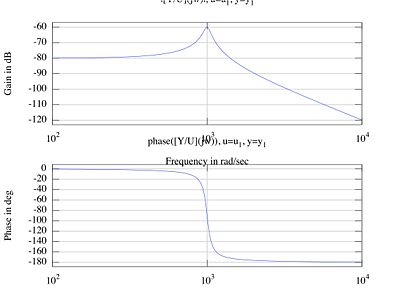|
|
| Line 79: |
Line 79: |
|
|
|
|
|
<br><br><br><br><br><br><br><br><br><br><br><br><br><br><br><br><br><br><br> |
|
<br><br><br><br><br><br><br><br><br><br><br><br><br><br><br><br><br><br><br> |
|
|
|
|
|
====Break Points==== |
|
|
We can also use break points to approximate and/or validate the Bode plot. |
|
|
|
|
|
The break points of our function are determined by the transfer function |
|
|
|
|
|
<math>H(s)=\dfrac{s^2}{(s^2+400)(0.01s^2+s+10000)}=\dfrac{100s^2}{(s^2+400)(s^2+100s+1000000)}</math> |
|
|
|
|
|
The break points are: |
|
|
|
|
|
<math>0 \upuparrows</math>(40db/decade up) |
|
|
<math>20 \downdownarrows</math>(40db/decade down) |
|
|
<math>1000 \downdownarrows</math>(40db/decade down) |
|
|
|
|
|
Looking at the top part of the Bode plot, we see that the graph is indeed going up from 0 to 20, and then is flat from 20 to 1000 since the break point at 20 counteracted the break point at 0. Finally, the graph is going down after 1000, and at about 40db/decade. |
|
|
|
|
|
---- |
|
---- |
Laplace Transform Example: Series RLC Circuit
Problem
Given a series RLC circuit with  ,
,  , and
, and  , having power source
, having power source  , find an expression for
, find an expression for  if
if  and
and  .
.
Solution
We begin with the general formula for voltage drops around the circuit:

Substituting numbers, we get


Now, we take the Laplace Transform and get
![{\displaystyle {\dfrac {s}{s^{2}+20^{2}}}=I+0.01[sI-i(0)]+10000{\dfrac {I}{s}}}](https://wikimedia.org/api/rest_v1/media/math/render/svg/d41d1c35be0a5e4fd3c631da2fa7024f9df58eac)
Using the fact that  , we get
, we get




Using partial fraction decomposition, we find that





Finally, we take the inverse Laplace transform to obtain

which is our answer.
Initial/Final Value Theorems
We now want to use the Initial and Final Value Theorems on this problem.
The Initial Value Theorem states that



In addition, when we actually evaluate  from our equation for
from our equation for  , we find it to be 0 as well. So, things check out there.
, we find it to be 0 as well. So, things check out there.
The Final Value Theorem states that



This time, when we actually evaluate i(∞) from the equation for  , we find it to be undefined. So here, the Final Value Theorem tells us something that is not necessarily true (in fact, because we have oscillating functions, we know that i(∞) will not be zero).
, we find it to be undefined. So here, the Final Value Theorem tells us something that is not necessarily true (in fact, because we have oscillating functions, we know that i(∞) will not be zero).
Bode Plot
To get a Bode plot, we use the transfer function:

We then use a program such as Octave or MATLAB to obtain the Bode plot, which looks like this:
Break Points
We can also use break points to approximate and/or validate the Bode plot.
The break points of our function are determined by the transfer function

The break points are:
 (40db/decade up)
(40db/decade up)
 (40db/decade down)
(40db/decade down)
 (40db/decade down)
(40db/decade down)
Looking at the top part of the Bode plot, we see that the graph is indeed going up from 0 to 20, and then is flat from 20 to 1000 since the break point at 20 counteracted the break point at 0. Finally, the graph is going down after 1000, and at about 40db/decade.
Written by Nathan Reeves ~ Checked by










![{\displaystyle {\dfrac {s}{s^{2}+20^{2}}}=I+0.01[sI-i(0)]+10000{\dfrac {I}{s}}}](https://wikimedia.org/api/rest_v1/media/math/render/svg/d41d1c35be0a5e4fd3c631da2fa7024f9df58eac)






















